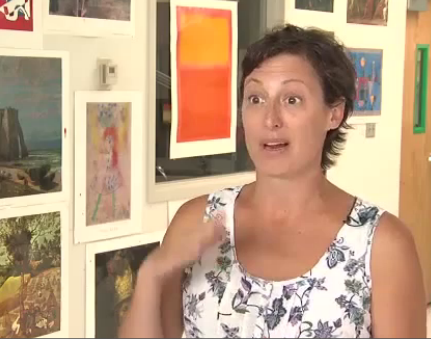Teachers, parents key to arts education survival
By Nadine Wimmer
SALT LAKE CITY — Erica Oberg moved her family to Utah because she was unhappy with the education system in California.
Upon her arrival, however, she was disappointed to find virtually no art program in her children’s new elementary school. Because of budget cuts, funding for the arts varies among school districts, as do the programs. So she made an interesting pitch to the principal.
“I said, I can either be your PTA president, PTO president, or I can make you an art program.’ And he’s like, I’ll take art.’ So we came up with a great program,” Oberg said. “We’re going into our third year.”
With a little help from a grant and stipend, Oberg now teaches the entire school. Every week the kids attend an art lecture, then create projects of their own.
“It’s learning in different ways, it’s giving them a sense of accomplishment,” Oberg said. “They leave every time with completing something.”
That “see a need, fill a need” approach to keeping arts in schools shows the conviction many have of its importance.
“If we want free thinkers, which I think this country is built upon, we need people that see outside the box, understand that there’s more than one way, more than one way to do things.”
–- Bill Mattingly, music teacher
It’s a conviction Bill Mattingly, a music teacher at Alta High School, shares. He’s worked for years to start an Alta High marching band.
“If we want free thinkers, which I think this country is built upon, we need people that see outside the box, understand that there’s more than one way, more than one way to do things,” Mattingly said. “And I think music thrives on that.”
But when schools make budget cuts, art and music programs are often among the first casualties. The Utah State Office of Education allows districts to decide whether to spend money on music or math.
“It’s kind of a case-by-case basis, if I need something, we’ve got to really kind of go to bat to make sure that we get it,” Mattingly said. “Sometimes I’m told no sometimes I’m told yes.”
Finances, Mattingly adds, is not the only hindrance to getting support for the program. He says scheduling is hard for middle school kids who have to choose between LDS Seminary, band, orchestra and gym classes, among others.
“It’s very limiting and, unfortunately, we have a lot of kids choosing away from the arts and they think they’ll take one year off and then they just decide not to come back,” he said.
Mattingly also says that equipment and personnel shortages prevent him from scheduling performances in the community.
“I get calls at least seven to 10 times a year for performances for marching band that we just can’t fulfill because we don’t have the equipment we don’t have the personnel to do it,” he said.









Leave a Reply
Want to join the discussion?Feel free to contribute!